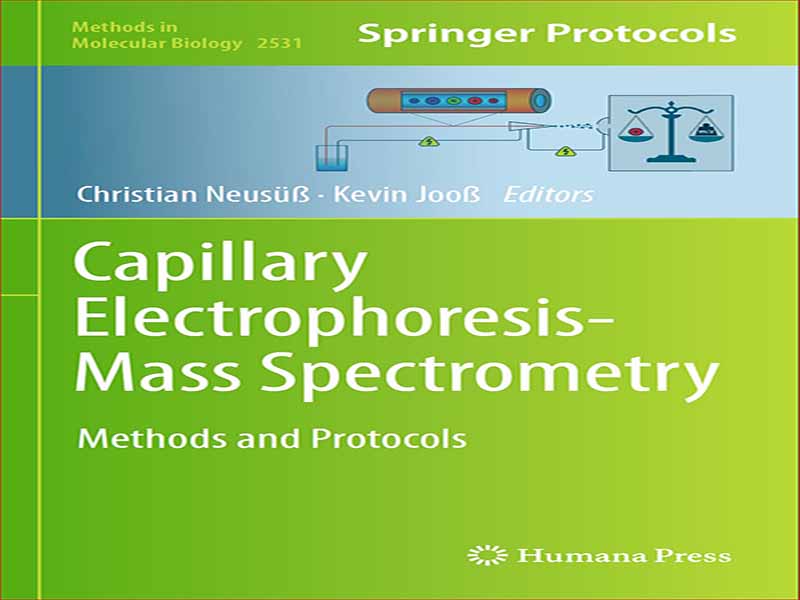- عنوان کتاب: Capillary Electrophoresis-Mass Spectrometry
- نویسنده: Christian Neusüß, Kevin Jooß
- حوزه: زیست شناسی مولکولی
- سال انتشار: 2022
- تعداد صفحه: 264
- زبان اصلی: انگلیسی
- نوع فایل: pdf
- حجم فایل: 10.7 مگابایت
الکتروفورز مویرگی- طیف سنجی جرمی (CE-MS) هنوز در مقایسه با طیف سنجی جرمی کروماتوگرافی مایع گسترده (LC-MS) یک روش کم استفاده است. با این وجود، انتخاب CE-MS را به ابزاری جذاب در بسیاری از زمینههای کاربردی تبدیل میکند که اغلب مکمل جداسازی LC سنتی در نظر گرفته میشود. به طور کلی، تکنیک های الکترومهاجری یون ها را بر اساس نسبت بار به اندازه و/یا نقطه ایزوالکتریک جدا می کنند. در نتیجه، راندمان جداسازی بالا را می توان به دست آورد، که به طور ایده آل منجر به قله های فوق العاده تیز تحت شرایط انتشار محدود می شود. به این ترتیب، میتوان گونههای نزدیک به هم مانند مولکولهای ایزومر (از جمله انانتیومرها) یا پروتئوفرمهایی را که تنها در یک اصلاح پس از ترجمه متفاوت هستند، حل کرد. CE نیاز به استفاده از میدان های الکتریکی بالا برای انجام جداسازی های سریع و کارآمد دارد که منجر به جریان های الکتریکی بالا می شود. در نتیجه، اتلاف گرمای کارآمد برای جلوگیری از گشاد شدن پیک و تشکیل حباب به دلیل گرمایش ژول مورد نیاز است. این منجر به هندسههای کوچک با سطح نسبتاً بالا میشود که منجر به حجم کل مویرگی معمولاً در محدوده میکرولیتر تک رقمی میشود. بنابراین، CE یک تکنیک جداسازی میکروسیال است که به دلیل مصرف کم آن از منابع (به عنوان مثال، حلال ها) دوستدار محیط زیست است. به همین دلیل، CE-MS مخصوصاً برای تجزیه و تحلیل نمونههای ارزشمند مناسب است، به عنوان مثال، اگر فقط مقادیر جزئی در دسترس باشد. با این حال، از سوی دیگر، آنالیت ها باید به اندازه کافی برای تشخیص حساس متمرکز شوند. علاوه بر این، جابجایی حجم های کوچک نیاز به مراقبت ویژه دارد و از نظر فنی می تواند چالش برانگیز باشد. طیف سنجی جرمی (MS) به عنوان یک تکنیک جهانی و انتخابی برای تعیین خصوصیات مولکول عمل می کند و می تواند به صورت هدفمند و غیرهدف استفاده شود. در دهههای گذشته، پیشرفتهای عظیمی در فناوری MS حاصل شده است که منجر به حساسیت بالا، سرعت بالا، افزایش قدرت تفکیک، توانایی تکه تکهشدن انتخابی مولکولهای کوچک و بزرگ و آخرین اما نه کماهمیت بهبود قابلیت استفاده کلی شده است. با این حال، تکنیکهای جداسازی به دلیل تداخل احتمالی در طول فرآیند یونیزاسیون و محدود بودن وضوح طیفسنجی جرمی بسیار مهم هستند، که به ویژه در زمینه نمونههای پیچیده مهم است. یونیزاسیون الکترواسپری (ESI) تکنیک انتخابی برای کوپلینگ برخط جداسازی فاز مایع است که به ویژه برای تکنیکهای مهاجرت الکتریکی صادق است. با این حال، نیاز به بستن مدارهای الکتریکی برای هر دو فرآیند CE و ESI در انتهای مویرگی جداسازی نیاز به طراحی های رابط منحصر به فرد دارد. علاوه بر این، گزینشپذیری تکنیکهای مهاجرت الکتریکی به طور قابلتوجهی تحت تأثیر نوع و غلظت اجزای الکترولیت پسزمینه (BGE) است. بسیاری از روشهای CE به دلیل ترکیبات غیرفرار به طور مستقیم با ESI-MS سازگار نیستند و برای بهترین عملکرد جداسازی لازم است. این نیازهای ویژه برای CE-MS در این کتاب مطرح شده است.
Capillary electrophoresis-mass spectrometry (CE-MS) is still an underutilized technique compared to the widespread liquid chromatography-mass spectrometry (LC-MS). Nevertheless, the selectivity makes CE-MS an attractive tool in many fields of application which is oftentimes considered complementary to traditional LC separation. In general, electromigrative techniques separate ions based on their charge-to-size ratio and/or isoelectric point. Consequently, high separation efficiency can be achieved, ideally resulting in exceptionally sharp peaks under diffusion-limited conditions. In this way, it is possible to resolve closely related species such as isomeric molecules (including enantiomers) or proteoforms varying in only one posttranslational modification. CE requires the application of high electric fields to performreasonably fast and efficient separations, resulting in high electric currents. Consequently, efficient heat dissipation is required to avoid peak broadening and bubble formation due to Joule heating. This leads to small geometries with relatively high surface resulting in total capillary volumes typically in the single digit microliter range. Thus, CE is a microfluidic separation technique considered environmentally friendly due to its low consumption of resources (e.g., solvents). For the same reason, CE-MS is particularly suitable for the analysis of valuable samples, e.g., if only minor amounts are available. However, on the other hand, analytes need to be sufficiently concentrated for sensitive detection. In addition, the handling of small volumes requires special care and can be technically challenging. Mass Spectrometry (MS) acts as a universal and selective technique for molecule characterization and can be applied in both targeted and nontargeted fashion. In the last decades, enormous progress has been made in MS technology leading to high sensitivity, high speed, increased resolving power, the ability for selective fragmentation of small and large molecules, and last but not least improved overall usability. Still, separation techniques are crucial due to possible interference during the ionization process and mass spectrometric resolution being limited, which is especially important in the context of complex samples. Electrospray Ionization (ESI) is the technique of choice for on-line coupling of liquid phase separations, which is particularly true for electromigrative techniques. However, the need for closing the electric circuits for both the CE and the ESI process at the end of the separation capillary requires unique interface designs. Moreover, the selectivity of electromigrative techniques is substantially influenced by the type and concentration of the components of the background electrolyte (BGE). Many CE methods are not compatible with ESI-MS in a direct fashion due to nonvolatile constituents, being required for best separation performance. These special needs for CE-MS are addressed in this book.
این کتاب را میتوانید بصورت رایگان از لینک زیر دانلود نمایید.




































نظرات کاربران